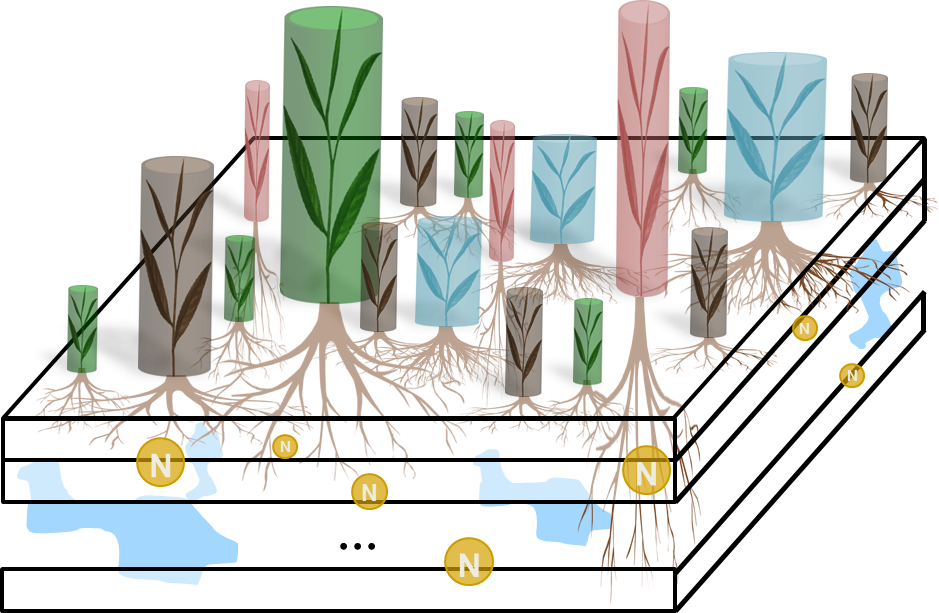Dr. Franziska Taubert
Leader of Working Group Grassland Modelling
Contact
Helmholtz Centre for Environmental Research - UFZ
Department of Ecological Modelling
Permoserstr. 15
04318 Leipzig
Germany
Building 1.0, Room 208
Tel.: +49 341 235-1896
Fax: +49 341 235-451896
franziska.taubert@ufz.de

Research interests
The research in my working group covers the areas of vegetation ecology and ecological modelling (with focus on grasslands) as well as Digital Twin developments and applications - with the following main research topics:
(1) understanding the emergence and maintenance of biodiversity in managed grasslands
(2) identifying links between plant species diversity, environmental conditions, human impacts and grassland ecosystem functions,
(3) identifying and explaining emergent vegetation patterns from field data and remote sensing products
To this end, we methodologically:
- develop and apply process-based grassland models of various complexity (see below the GRASSMIND model as example)
- transfer ecological modelling approaches and workflows into Digital Twin applications
- couple two or more predictive models describing landscape components to create a comprehensive model system,
- analyse and advance methodological approaches in vegetation ecology
The GRASSMIND model
We have developed the dynamic grassland model GRASSMIND (individual- and process-based) for simulating plant growth and dynamics of species-rich managed temperate grasslands. The model simulates the daily growth dynamics of individual plants and thereby explicitly considers
- competition between individual plants for light, space, soil water and nitrogen
- different management regimes (e.g. mowing, irrigation, fertilization)
- climatic variables and potential changes (e.g. increasing air temperatures, reduced soil water)


Since its initial development, the model constantly has further been advanced and applied to different German study sites to understand how plant traits (and related vegetation processes) influence grassland productivity and species composition.
Important publications:
- Schmid, J. S., Huth, A., & Taubert, F. (2022). Impact of mowing frequency and temperature on the production of temperate grasslands: explanations received by an individual‐based model. Oikos, 2022(9), e09108. full text (doi)
- Hetzer, J., Huth, A., Taubert, F., (2021): The importance of plant trait variability in grasslands: a modelling study. Ecol. Model. 453 , art. 109606. full text (doi)
- Schmid, J.S., Huth, A., Taubert, F., (2021): Influences of traits and processes on productivity and functional composition in grasslands: A modeling study. Ecol. Model. 440 , art. 109395. full text (doi)
- Taubert, F., Hetzer, J., Schmid, J.S., Huth, A., (2020): The role of species traits for grassland productivity. Ecosphere 11 (7), e03205. full text (doi)
- Taubert, F., Hetzer, J., Schmid, J.S., Huth, A., (2020): Confronting an individual-based simulation model with empirical community patterns of grasslands. PLOS One 15 (7), e0236546. full text (doi)
- Taubert, F., Frank, K., Huth, A., (2012): A review of grassland models in the biofuel context. Ecol. Model. 245 , 84 - 93. full text (doi)
Here you can download the GRASSMIND model and its model description.
Current projects
EU-HORIZON Infrastructure project BioDT "Biodiversity Digital Twin for Advanced Modelling, Simulation and Prediction Capabilities"
- Development of a Digital Twin prototype of grassland plant diversity dynamics for local grassland sites in Europe (link)
- Work package leader of WP6 "Simulation, Modelling and Data Analytics"
LandTrans "Simulator: Modular system of SMART terrestrial models"
- Leader of team LandVeg (Vegetation Modelling) covering the vegetation models GRASSMIND and FORMIND
- One of the PIs of the PhD College LISA on "The challenge to explore multifunctional landscapes in a model-based framework: model interfaces and scaling issues"
- PhD project in PhD Colleg LISA on "Modelling ecological and socio-economic impacts of grasslands"
- Banitz, T., Rossi, T., Taubert, F. (2025):
BioDT/general-copernicus-weather-data
Version: v1.2 Zenodo 10.5281/zenodo.17233179 - Banitz, T., Rossi, T., Taubert, F. (2025):
BioDT/general-soilgrids-soil-data
Version: v1.2 Zenodo 10.5281/zenodo.17234319 - Davison, A.M., de Koning, K., Taubert, F., Schakel, J.-K. (2025):
Automated near real-time monitoring in ecology: Status quo and ways forward
Ecol. Inform. 89 , art. 103157 10.1016/j.ecoinf.2025.103157 - Iakunin, M., Taubert, F., Goss, R., Sasso, S., Feilhauer, H., Doktor, D. (2025):
Grassland management and phenology affect trait retrieval accuracy from remote sensing observations
Ecol. Inform. 87 , art. 103068 10.1016/j.ecoinf.2025.103068 - Taubert, F., Rossi, T., Wohner, C., Venier, S., Martinovič, T., Khan, T., Gordillo, J., Banitz, T. (2024):
Prototype Biodiversity Digital Twin: grassland biodiversity dynamics
Res. Ideas Outcomes 10 , e124168 10.3897/rio.10.e124168 - de Koning, K., Broekhuijsen, J., Kühn, I., Ovaskainen, O., Taubert, F., Endresen, D., Schigel, D., Grimm, V. (2023):
Digital twins: dynamic model-data fusion for ecology
Trends Ecol. Evol. 38 (10), 916 - 926 10.1016/j.tree.2023.04.010 - Nothaaß, D., Taubert, F., Huth, A., Clark, A.T. (2023):
Modelling species invasion using a metapopulation model with variable mortality and stochastic birth-death processes
Ecol. Model. 481 , art. 110372 10.1016/j.ecolmodel.2023.110372 - Taubert, F., Banitz, T., Wohner, C. (2023):
Guideline on how to provide data from a grassland site for simulations with the GRASSMIND model
Zenodo
10.5281/zenodo.10125790 - Wu, M.M., Liang, Y., Taubert, F., Huth, A., Zhang, M., Wang, X. (2023):
Sensitivity of forest composition and productivity to climate change in mixed broadleaved-Korean pine forest of Northeastern China
Ecol. Model. 483 , art. 110434 10.1016/j.ecolmodel.2023.110434 - Dressler, G., Groeneveld, J., Hetzer, J., Janischewski, A., Nolzen, H., Rödig, E., Schwarz, N., Taubert, F., Thober, J., Will, M., Williams, T., Wirth, S.B., Müller, B. (2022):
Upscaling in socio-environmental systems modelling: Current challenges, promising strategies and insights from ecology
Socio-Environmental Systems Modelling 4 , art. 18112 10.18174/sesmo.18112 - Giuffrida, R., Schigel, D., Endresen, D., Taubert, F., Ovaskainen, O., Chala, D., Grimm, V., Kühn, I., Ingenloff, K., Frøslev, T., Golivets, M., Dick, J., Watkins, J., Chase, J., Groeneveld, J. (2022):
The BioDT use cases: unique demonstrators to test the biodiversity Digital Twin prototype
Zenodo
10.5281/zenodo.7373622 - Liebscher, E., Taubert, F., Waltschew, D., Hetzer, J. (2022):
Modelling multivariate data using product copulas and minimum distance estimators: an exemplary application to ecological traits
Environ. Ecol. Stat. 29 (2), 315 - 338 10.1007/s10651-021-00525-0 - Schmid, J.S., Huth, A., Taubert, F. (2022):
Impact of mowing frequency and temperature on the production of temperate grasslands: explanations received by an individual-based model
Oikos 2022 (9), e09108 10.1111/oik.09108 - Clark, A.T., Arnoldi, J.-F., Zelnik, Y.R., Barabas, G., Hodapp, D., Karakoç, C., König, S., Radchuk, V., Donohue, I., Huth, A., Jacquet, C., de Mazancourt, C., Mentges, A., Nothaaß, D., Shoemaker, L.G., Taubert, F., Wiegand, T., Wang, S., Chase, J.M., Loreau, M., Harpole, S. (2021):
General statistical scaling laws for stability in ecological systems
Ecol. Lett. 24 (7), 1474 - 1486 10.1111/ele.13760 - Fischer, R., Taubert, F., Müller, M.S., Groeneveld, J., Lehmann, S., Wiegand, T., Huth, A. (2021):
Accelerated forest fragmentation leads to critical increase in tropical forest edge area
Sci. Adv. 7 (37), eabg7012 10.1126/sciadv.abg7012 - Hetzer, J., Huth, A., Taubert, F. (2021):
The importance of plant trait variability in grasslands: a modelling study
Ecol. Model. 453 , art. 109606 10.1016/j.ecolmodel.2021.109606 - Maréchaux, I., Langerwisch, F., Huth, A., Bugmann, H., Morin, X., Reyer, C.P.O., Seidl, R., Collalti, A., Dantas de Paula, M., Fischer, R., Gutsch, M., Lexer, M.J., Lischke, H., Rammig, A., Rödig, E., Sakschewski, B., Taubert, F., Thonicke, K., Vacchiano, G., Bohn, F.J. (2021):
Tackling unresolved questions in forest ecology: The past and future role of simulation models
Ecol. Evol. 11 (9), 3746 - 3770 10.1002/ece3.7391 - Schmid, J.S., Huth, A., Taubert, F. (2021):
Influences of traits and processes on productivity and functional composition in grasslands: A modeling study
Ecol. Model. 440 , art. 109395 10.1016/j.ecolmodel.2020.109395 - Taubert, F., Fischer, R., Knapp, N., Huth, A. (2021):
Deriving tree size distributions of tropical forests from lidar
Remote Sens. 13 (1), art. 131 10.3390/rs13010131 - Wirth, S.B., Taubert, F., Tietjen, B., Müller, C., Rolinski, S. (2021):
Do details matter? Disentangling the processes related to plant species interactions in two grassland models of different complexity
Ecol. Model. 460 , art. 109737 10.1016/j.ecolmodel.2021.109737 - di Porcia e Brugnera, M., Fischer, R., Taubert, F., Huth, A., Verbeeck, H. (2020):
Lianas in silico, ecological insights from a model of structural parasitism
Ecol. Model. 431 , art. 109159 10.1016/j.ecolmodel.2020.109159 - Schmid, J.S., Taubert, F., Wiegand, T., Sun, I.-F., Huth, A. (2020):
Network science applied to forest megaplots: tropical tree species coexist in small-world networks
Sci. Rep. 10 , art. 13198 10.1038/s41598-020-70052-8 - Shoemaker, L.G., Sullivan, L.L., Donohue, I., Cabral, J.S., Williams, R.J., Mayfield, M.M., Chase, J.M., Chu, C., Harpole, W.S., Huth, A., HilleRisLambers, J., James, A.R.M., Kraft, N.J.B., May, F., Muthukrishnan, R., Satterlee, S., Taubert, F., Wang, X., Wiegand, T., Yang, Q., Abbott, K.C. (2020):
Integrating the underlying structure of stochasticity into community ecology
Ecology 101 (2), e02922 10.1002/ecy.2922 - Taubert, F., Hetzer, J., Schmid, J.S., Huth, A. (2020):
The role of species traits for grassland productivity
Ecosphere 11 (7), e03205 10.1002/ecs2.3205 - Taubert, F., Hetzer, J., Schmid, J.S., Huth, A. (2020):
Confronting an individual-based simulation model with empirical community patterns of grasslands
PLOS One 15 (7), e0236546 10.1371/journal.pone.0236546 - Dantas de Paula, M., Groeneveld, J., Fischer, R., Taubert, F., Martins, V.F., Huth, A. (2018):
Defaunation impacts on seed survival and its effect on the biomass of future tropical forests
Oikos 127 (10), 1526 - 1538 10.1111/oik.05084 - Landuyt, D., Perring, M.P., Seidl, R., Taubert, F., Verbeeck, H., Verheyen, K. (2018):
Modelling understorey dynamics in temperate forests under global change–Challenges and perspectives
Perspect. Plant Ecol. Evol. Syst. 31 , 44 - 54 10.1016/j.ppees.2018.01.002 - Rödig, E., Cuntz, M., Rammig, A., Fischer, R., Taubert, F., Huth, A. (2018):
The importance of forest structure for carbon fluxes of the Amazon rainforest
Environ. Res. Lett. 13 (5), art. 054013 10.1088/1748-9326/aabc61 - Taubert, F., Fischer, R., Groeneveld, J., Lehmann, S., Müller, M.S., Rödig, E., Wiegand, T., Huth, A. (2018):
Global patterns of tropical forest fragmentation
Nature 554 (7693), 519 - 522 10.1038/nature25508 - Naegler, T., Szarka, N., Henning, H.-M., Brendel, R., Niepelt, R., Taubert, F., Fischedick, M. (2017):
Transformationsszenarien für das deutsche Energiesystem
In: Szczepanski, P., Wunschick, F., Martin, N. (Hrsg.)
Forschung für die Energiewende - Die Gestaltung des Energiesystems. Beiträge zur Jahrestagung 2016 des ForschungsVerbunds Erneuerbare Energien, 2. und 3. November 2016, Umweltforum Berlin
FVEE-Themen 2016
ForschungsVerbund Erneuerbare Energien (FVEE), Berlin, 6 - 10 - Fischer, R., Bohn, F., Dantas de Paula, M., Dislich, C., Groeneveld, J., Gutiérrez, A.G., Kazmierczak, M., Knapp, N., Lehmann, S., Paulick, S., Pütz, S., Rödig, E., Taubert, F., Köhler, P., Huth, A. (2016):
Lessons learned from applying a forest gap model to understand ecosystem and carbon dynamics of complex tropical forests
Ecol. Model. 326 , 124 - 133 10.1016/j.ecolmodel.2015.11.018 - Kazmierczak, M., Backmann, P., Fedriani, J.M., Fischer, R., Hartmann, A.K., Huth, A., May, F., Müller, M.S., Taubert, F., Grimm, V., Groeneveld, J. (2016):
Monodominance in tropical forests: modelling reveals emerging clusters and phase transitions
J. R. Soc. Interface 13 (117), art. 0123 10.1098/rsif.2016.0123 - Taubert, F., Jahn, M.W., Dobner, H.-J., Wiegand, T., Huth, A. (2015):
The structure of tropical forests and sphere packings
Proc. Natl. Acad. Sci. U.S.A. 112 (49), 15125 - 15129 10.1073/pnas.1513417112 - Taubert, F. (2014):
Modelling and analysing the structure and dynamics of species-rich grasslands and forests
Dissertation, Universität Osnabrück
PhD Dissertation 5/2014
Helmholtz-Zentrum für Umweltforschung - UFZ, Leipzig, 148 pp. - Taubert, F., Hartig, F., Dobner, H.-J., Huth, A. (2013):
On the challenge of fitting tree size distributions in ecology
PLOS One 8 (2), e58036 10.1371/journal.pone.0058036 - Taubert, F., Frank, K., Huth, A. (2012):
A review of grassland models in the biofuel context
Ecol. Model. 245 , 84 - 93 10.1016/j.ecolmodel.2012.04.007
| since 2019 | Leader of Working Group Grassland Modelling |
| since 2013 | Postdoc at the Department of Ecological Modelling |
| 2010 - 2013 | PhD student at the Department of Ecological Modelling |
| 2008 - 2010 | Master in Applied Mathematics at the University of Applied Science (HTWK) Leipzig |
| 2004 - 2008 | Diploma in Business Mathematics at the University of Applied Science (HTWK) Leipzig |
